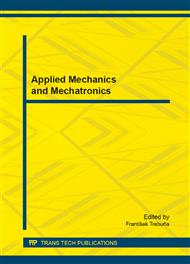[1]
D. Deng, N. Ma, H. Murakawa, A computational approach on prediction of welding residual stress with considering solid state phase transformations, transactions of JWRI, Special Issue on WSE2011, 2011, pp.79-82.
Google Scholar
[2]
Y. Ueda, H. Murakawa, N. Ma, Welding deformation and residual stress, Elsevier, (2012).
Google Scholar
[3]
P. Novák, J. Meško, M. Žmindák, Thermal cycle and residual stresses in weld deposite. In Machine modelling and simulations, Žilina, (2009).
Google Scholar
[4]
H. Dai, J. A. Francis, P.J. Withers, Prediction of residual stress distributions for single weld beads deposited on to SA508 steel including phase transformation effects, Materials Science and Technology Vol 26, Issue 8 (01 August 2010), pp.940-949.
DOI: 10.1179/026708309x12459430509454
Google Scholar
[5]
A. Vega, S. Rashed, Y. Tango, M. Ishiyama, H. Murakawa, Analysis and prediction of multi-heating lines effect on plate forming by line heating. CMES Journal: Computer Modeling in Engineering & Sciences, CMES, Vol. 28, No. 1, pp.1-14, (2008).
Google Scholar
[6]
J.A. Goldak, M Akhlaghi, Computational welding mechanics, Springer, (2005).
Google Scholar
[7]
L.E. Lindgren, Computational welding mechanics – thermomechanical and microstructural simulations, Woodhead publishing, Cambridge, England, (2007).
Google Scholar
[8]
Z. Zhang, R.A. Farrar, An Atlas of Continuous Cooling Transformation (Cct) Diagrams Applicable to Low Carbon Low Alloy Weld Metals, Institute of Materials, London, (1995).
DOI: 10.1201/9781003070405-1
Google Scholar
[9]
J.B. Leblond, G. Mottet, J. Devaux, J. C. Devaux, Mathematical models of anisothermal phase transformations in steels, and predicted plastic behaviour, Materials Science and Technology, Volume 1 Issue 10 (01 October 1985), pp.815-822.
DOI: 10.1179/mst.1985.1.10.815
Google Scholar
[10]
J.B. Leblond, J. Devaux, A new kinetic model for anisothermal metallurgical transformations in steels including effect of austenite grain size, Acta metal. Vol. 32, No. 1, pp.137-146, (1984).
DOI: 10.1016/0001-6160(84)90211-6
Google Scholar
[11]
P. Papon, J. Leblond, P.H.E. Meijer, The physics of phase transitions – concepts and applications, Springer, (2006).
Google Scholar
[12]
V.D. Fachinotti, A. Cardona, A.A. Anca, Solid-state microstructure evolution in steels, Mecanica Computacional Vol. XXIV, Buenos Aires, argentina, Noviembre (2005).
Google Scholar
[13]
R.V. Andrade, Pipe circularity via line heating, Massachusetts Institute of Technology (2001).
Google Scholar


